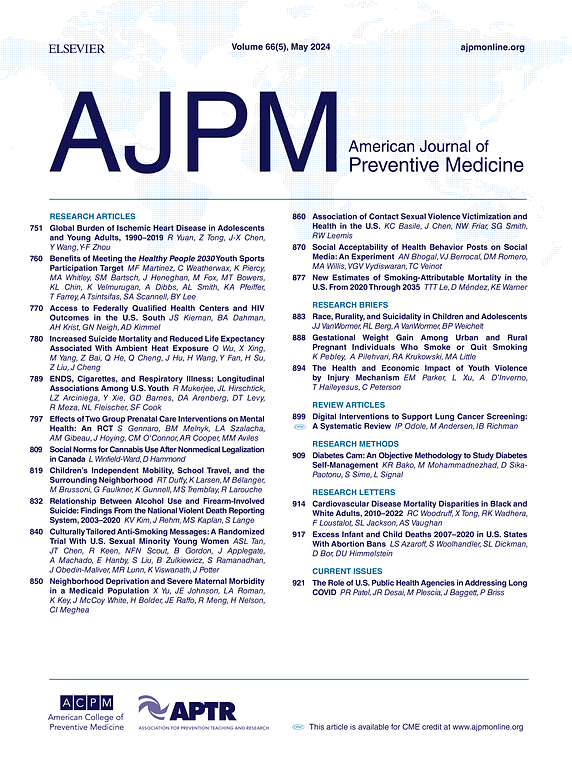Firearm Violence and Dental Health: A Neighborhood Analysis in 100 U.S. Cities, 2014–2022
IF 4.3
2区 医学
Q1 MEDICINE, GENERAL & INTERNAL
引用次数: 0
Abstract
Introduction
This study examined the relationship between community-level firearm violence and dental health, focusing on dental care utilization and edentulism (i.e., total tooth loss) .
Methods
The authors analyzed 20, 332 census tracts within the 100 largest U.S. cities from 2014 to 2022. Dental care utilization and edentulism rates were sourced from the Centers for Disease Control and Prevention's PLACES project. Firearm violence data was drawn from the American Violence Project. Lagged random intercept mixed-effects models estimated associations between firearm violence and dental outcomes, adjusting for neighborhood demographic and socioeconomic covariates. Analyses were performed in 2024.
Results
Increases in firearm violence were associated with lower dental care utilization and higher rates of edentulism. A 1-shooting increase corresponded to a 0.01% reduction in dental care utilization and a 0.06% increase in edentulism the following year.
Conclusions
Neighborhoods experiencing higher levels of firearm violence face disparities in dental care and oral health, highlighting firearm violence as a social determinant of oral health. Interventions such as mobile dental clinics and integrating dental care into violence intervention programs could mitigate disparities in dental care access and oral health in communities affected by firearm violence.
枪支暴力和牙齿健康:2014-2022年美国100个城市的社区分析。
简介:本研究探讨了社区枪支暴力与牙齿健康之间的关系,重点关注牙科保健利用率和牙齿缺失率(即牙齿全损):本研究探讨了社区枪支暴力与牙齿健康之间的关系,重点关注牙科保健利用率和牙齿缺失(即全口牙齿缺失):作者分析了 2014 年至 2022 年期间美国最大的 100 座城市中的 20332 个人口普查区。牙科保健利用率和牙齿缺失率来自美国疾病控制和预防中心的 PLACES 项目。枪支暴力数据来自美国暴力项目。滞后随机截距混合效应模型估计了枪支暴力与牙科治疗结果之间的关联,并对邻近人口和社会经济协变量进行了调整。分析在 2024 年进行:结果:枪支暴力的增加与较低的牙科保健利用率和较高的镶牙率有关。枪击事件每增加 1 起,牙科保健利用率就会下降 0.01%,而第二年的牙齿修补率则会上升 0.06%:结论:枪支暴力程度较高的居民区在牙科保健和口腔健康方面存在差异,这凸显了枪支暴力是口腔健康的一个社会决定因素。流动牙科诊所和将牙科保健纳入暴力干预计划等干预措施可减轻受枪支暴力影响社区在牙科保健和口腔健康方面的差距。
本文章由计算机程序翻译,如有差异,请以英文原文为准。
求助全文
约1分钟内获得全文
求助全文
来源期刊

American Journal of Preventive Medicine
医学-公共卫生、环境卫生与职业卫生
CiteScore
8.60
自引率
1.80%
发文量
395
审稿时长
32 days
期刊介绍:
The American Journal of Preventive Medicine is the official journal of the American College of Preventive Medicine and the Association for Prevention Teaching and Research. It publishes articles in the areas of prevention research, teaching, practice and policy. Original research is published on interventions aimed at the prevention of chronic and acute disease and the promotion of individual and community health.
Of particular emphasis are papers that address the primary and secondary prevention of important clinical, behavioral and public health issues such as injury and violence, infectious disease, women''s health, smoking, sedentary behaviors and physical activity, nutrition, diabetes, obesity, and substance use disorders. Papers also address educational initiatives aimed at improving the ability of health professionals to provide effective clinical prevention and public health services. Papers on health services research pertinent to prevention and public health are also published. The journal also publishes official policy statements from the two co-sponsoring organizations, review articles, media reviews, and editorials. Finally, the journal periodically publishes supplements and special theme issues devoted to areas of current interest to the prevention community.
 求助内容:
求助内容: 应助结果提醒方式:
应助结果提醒方式:


